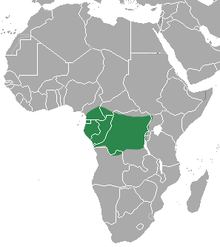| Congo clawless otter | |
|---|---|

| |
| Scientific classification | |
| Domain: | Eukaryota |
| Kingdom: | Animalia |
| Phylum: | Chordata |
| Class: | Mammalia |
| Order: | Carnivora |
| Family: | Mustelidae |
| Genus: | Aonyx |
| Species: | A. congicus
|
| Binomial name | |
| Aonyx congicus Lönnberg, 1910
| |

| |
| Congo clawless otter range | |
The Congo clawless otter (Aonyx congicus), also known as the Cameroon clawless otter, is a species in the family Mustelidae.[1][2] It was formerly recognised as a subspecies (Aonyx capensis congicus) of the African clawless otter.[3][4]
This clawless otter is found in Angola, Cameroon, Central African Republic, Republic of the Congo, Democratic Republic of the Congo, Equatorial Guinea, Gabon, Rwanda, Uganda, and possibly Burundi and Nigeria.[1] Its natural habitats are subtropical or tropical moist lowland forest, subtropical or tropical mangrove forest, subtropical or tropical swamps, subtropical or tropical moist montane forest, subtropical or tropical moist shrubland, subtropical or tropical seasonally wet or flooded lowland grassland, rivers, intermittent rivers, shrub-dominated wetlands, swamps, freshwater lakes, intermittent freshwater lakes, freshwater marshes, intermittent freshwater marshes, freshwater spring, inland deltas, saline lakes, intermittent saline lakes, saline marshes, intermittent saline marshes, shallow seas, subtidal aquatic beds, rocky shores, sandy shores, estuarine waters, intertidal flats, intertidal marshes, coastal saline lagoons, coastal freshwater lagoons, water storage areas, ponds, aquaculture ponds, seasonally flooded agricultural land, and canals and ditches. It is threatened by habitat loss.
Very little is known about this species. It is a large otter and found only in the mid-part of Africa, in the tropical belt. It is believed to spend much more time on land than other otters. Congo clawless otters are one of 14 species of otters in the carnivore family Mustelidae. Other members of this family include weasels, wolverines, and ferrets. An individual otter maintains a territory. Otters mark their territories with scent, and fervently patrol and defend their territories.
- ^ a b c d Jacques, H.; Reed-Smith, J.; Davenport, C.; Somers, M.J. (2021). "Aonyx congicus". IUCN Red List of Threatened Species. 2021: e.T1794A164576337. doi:10.2305/IUCN.UK.2021-3.RLTS.T1794A164576337.en. Retrieved 12 December 2022.
- ^ "Congo Clawless Otter (Aonyx congicus)". IUCN Otter Specialist Group. Retrieved 19 August 2020.
- ^ Wozencraft, W. C. (2005). "Order Carnivora". In Wilson, D. E.; Reeder, D. M. (eds.). Mammal Species of the World: A Taxonomic and Geographic Reference (3rd ed.). Johns Hopkins University Press. pp. 532–628. ISBN 978-0-8018-8221-0. OCLC 62265494.
- ^ ITIS Standard Report Page: Aonyx capensis congicus. Itis.gov. Retrieved on 2013-01-10.
